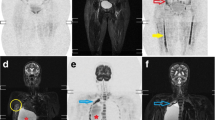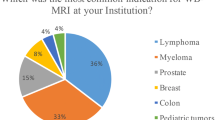Abstract
Purpose
To assess the incidence of collateral findings detected on whole-body magnetic resonance (WB-MRI) scans performed on patients with lymphoma.
Materials and methods
114 patients (65 male; median age 45.2 years, range 15–86) with histologically confirmed lymphoma (47 Hodgkin, 67 Non-Hodgkin) underwent WB-MRI. The collateral findings were classified into three classes, according to their clinical significance, as follows: not or low significant (class 1), moderately or potentially significant (class 2), and significant (class 3). A Chi-square (χ 2) test was performed to assess the statistical significance of differences in the incidence of collateral findings based on age (≤50 and >50 years old), gender and histology (Hodgkin and Non-Hodgkin Lymphoma).
Results
Ninety-one of 114 patients (79.8 %) had one or more incidental findings on WB-MRI. Collateral findings were more frequent in class 1 (43 %); abnormalities found in 35 patients (30.7 %) were considered potentially significant, whereas seven patients (6.1 %) demonstrated significant collateral findings requiring immediate treatment or further diagnostic evaluation. Collateral findings were more frequent in subjects over 50 years old compared to those of 50 years old or younger; differences were statistical significant (χ 2 = 8.42, p < 0.05). There were not statistically significant differences related to gender (χ 2 = 0.17, p > 0.05) and histology (χ 2 = 0.24, p > 0.05).
Conclusion
WB-MRI is an attractive procedure that allows to detect incidental abnormalities of organs not involved by disease offering the opportunity to obtain an early diagnosis of asymptomatic life-threatening diseases.



Similar content being viewed by others
References
Lin C, Itti E, Luciani A, Haioun C, Meignan M, Rahmouni A (2010) Whole-body diffusion-weighted imaging in lymphoma. Cancer Imaging 10:S172–S178
Lin C, Luciani A, Itti E et al (2010) Whole-body diffusion-weighted magnetic resonance imaging with apparent diffusion coefficient mapping for staging patients with diffuse large B-cell lymphoma. Eur Radiol 20:2027–2038
Abdulqadhr G, Molin D, Aström G et al (2011) Whole-body diffusion-weighted imaging compared with FDG-PET/CT in staging of lymphoma patients. Acta Radiol 52:173–180
Albano D, Patti C, La Grutta L et al (2016) Comparison between whole-body MRI with diffusion-weighted imaging and PET/CT in staging newly diagnosed FDG-avid lymphomas. Eur J Radiol 85:313–318
Wu X, Kellokumpu-Lehtinen PL, Pertovaara H et al (2011) Diffusion weighted MRI in early chemotherapy response evaluation of patients with diffuse large B-cell lymphoma—a pilot study: comparison with 2-deoxy-2-fluoro-d-glucose-positron emission tomography/computed tomography. NMR Biomed 24:1181–1190
De Paepe K, Bevernage C, De Keyzer F et al (2013) Whole-body diffusion-weighted magnetic resonance imaging at 3 T for early assessment of treatment response in non-Hodgkin lymphoma: a pilot study. Cancer Imaging 13:53–62
Wu X, Nerisho S, Dastidar P et al (2013) Comparison of different MRI sequences in lesion detection and early response evaluation of diffuse large B-cell lymphoma: a whole body MRI and diffusion-weighted imaging study. NMR Biomed 26:1186–1194
Tsuji K, Kishi S, Tsuchida T et al (2015) Evaluation of staging and early response to chemotherapy with whole-body diffusion-weighted MRI in malignant lymphoma patients: a comparison with FDG-PET/CT. J Magn Reson Imaging 41:1601–1607
Kwee TC, Takahara T, Ochiai R et al (2010) Complementary roles of whole-body diffusion-weighted MRI and 18F-FDG PET: the state of the art and potential applications. J Nucl Med 51:1549–1558
Kwee TC, Takahara T, Ochiai R et al (2008) Diffusion-weighted whole body imaging with background body signal suppression (DWIBS): features and potential applications in oncology. Eur Radiol 18:1937–1952
Cieszanowski A, Maj E, Kulisiewicz P et al (2014) Non-contrast-enhanced whole-body magnetic resonance imaging in the general population: the incidence of abnormal findings in patients 50 years old and younger compared to older subjects. PLoS One 26(9):e107840
Schmidt CO, Hegenscheid K, Erdmann P et al (2013) Psychosocial consequences and severity of disclosed incidental findings from whole-body MRI in a general population study. Eur Radiol 23:1343–1351
Hegenscheid K, Seipel R, Schmidt CO et al (2013) Potentially relevant incidental findings on research whole-body MRI in the general adult population: frequencies and management. Eur Radiol 23:816–826
Hegenscheid K, Kühn JP, Völzke H, Biffar R, Hosten N, Puls R (2009) Whole-body magnetic resonance imaging of healthy volunteers: pilot study results from the population-based SHIP study. Rofo 181:748–759
Morin SH, Cobbold JF, Lim AK et al (2009) Incidental findings in healthy control research subjects using whole-body MRI. Eur J Radiol 72:529–533
Lo GG, Ai V, Au-Yeung KM, Chan JK, Li KW, Chien D (2008) Magnetic resonance whole body imaging at 3 Tesla: feasibility and findings in a cohort of asymptomatic medical doctors. Hong Kong Med J 14:90–96
Illes J, Kirschen MP, Karetsky K et al (2004) Discovery and disclosure of incidental findings in neuroimaging research. J Magn Reson Imaging 20:743–747
La Grutta L, Malagò R, Maffei E et al (2015) Collateral non cardiac findings in clinical routine CT coronary angiography: results from a multi-center registry. Radiol Med 120:1122–1129
Cademartiri F, Malagò R, Belgrano M et al (2007) Spectrum of collateral findings in multislice CT c, oronary angiography. Radiol Med 112:937–948
Sconfienza LM, Mauri G, Muzzupappa C et al (2015) Relevant incidental findings at abdominal multi-detector contrast-enhanced computed tomography: a collateral screening? World J Radiol 28(7):350–356
Padia SA, Freyvogel M, Dietz J et al (2016) False-positive extra-mammary findings in breast MRI: another cause for concern. Breast J 22:90–95
Rinaldi P, Costantini M, Belli P et al (2011) Extra-mammary findings in breast MRI. Eur Radiol 21:2268–2276
Pickhardt PJ, Choi JR, Hwang I et al (2003) Computed tomographic virtual colonoscopy to screen for colorectal neoplasia in asymptomatic adults. N Engl J Med 349:2191–2200
Yee J, Kumar NN, Godara S et al (2005) Extracolonic abnormalities discovered incidentally at CT colonography in a male population. Radiology 236:519–526
Kim BS, Illes J, Kaplan RT, Reiss A, Atlas SW (2002) Incidental findings on pediatric MR images of the brain. AJNR Am J Neuroradiol 23:1674–1677
Baker LC, Atlas SW, Afendulis CC (2008) Expanded use of imaging technology and the challenge of measuring value. Health Aff (Millwood) 27:1467–1478
Quattrocchi CC, Giona A, Di Martino AC et al (2013) Extra-spinal incidental findings at lumbar spine MRI in the general population: a large cohort study. Insights Imaging 4:301–308
Albano D, La Grutta L, Grassedonio E et al (2016) Pitfalls in whole body MRI with diffusion weighted imaging performed on patients with lymphoma: what radiologists should know. Magn Res Imaging 34:922–931
Schmidt GP, Baur-Melnyk A, Herzog P et al (2005) High-resolution whole-body magnetic resonance image tumor staging with the use of parallel imaging versus dual-modality positron emission tomography-computed tomography: experience on a 32-channel system. Invest Radiol 40:743–753
Ghanem NA, Pache G, Lohrmann C et al (2007) MRI and (18) FDG-PET in the assessment of bone marrow infiltration of the spine in cancer patients. Eur Spine J 16:1907–1912
Giles SL, deSouza NM, Collins DJ et al (2015) Assessing myeloma bone disease with whole-body diffusion-weighted imaging: comparison with x-ray skeletal survey by region and relationship with laboratory estimates of disease burden. Clin Radiol 70:614–621
Fosså A, Fiskvik IH, Kolstad A et al (2012) Two escalated followed by six standard BEACOPP in advanced-stage high-risk classical Hodgkin lymphoma: high cure rates but increased risk of aseptic osteonecrosis. Ann Oncol 23:1254–1259
Orme NM, Fletcher JG, Siddiki HA et al (2010) Incidental findings in imaging research: evaluating incidence, benefit, and burden. Arch Intern Med 170:1525–1532
Author information
Authors and Affiliations
Corresponding author
Ethics declarations
Conflict of interests
The authors declare that they have no conflict of interest.
Ethical standards
All procedures performed in studies involving human participants were in accordance with the ethical standards of the institutional and/or national research committee and with the 1964 Helsinki declaration and its later amendments or comparable ethical standards. For this type of study, formal consent is not required.
Informed consent
Informed consent was obtained from all individual participants included in the study.
Rights and permissions
About this article
Cite this article
Galia, M., Albano, D., Narese, D. et al. Whole-body MRI in patients with lymphoma: collateral findings. Radiol med 121, 793–800 (2016). https://doi.org/10.1007/s11547-016-0658-x
Received:
Accepted:
Published:
Issue Date:
DOI: https://doi.org/10.1007/s11547-016-0658-x




